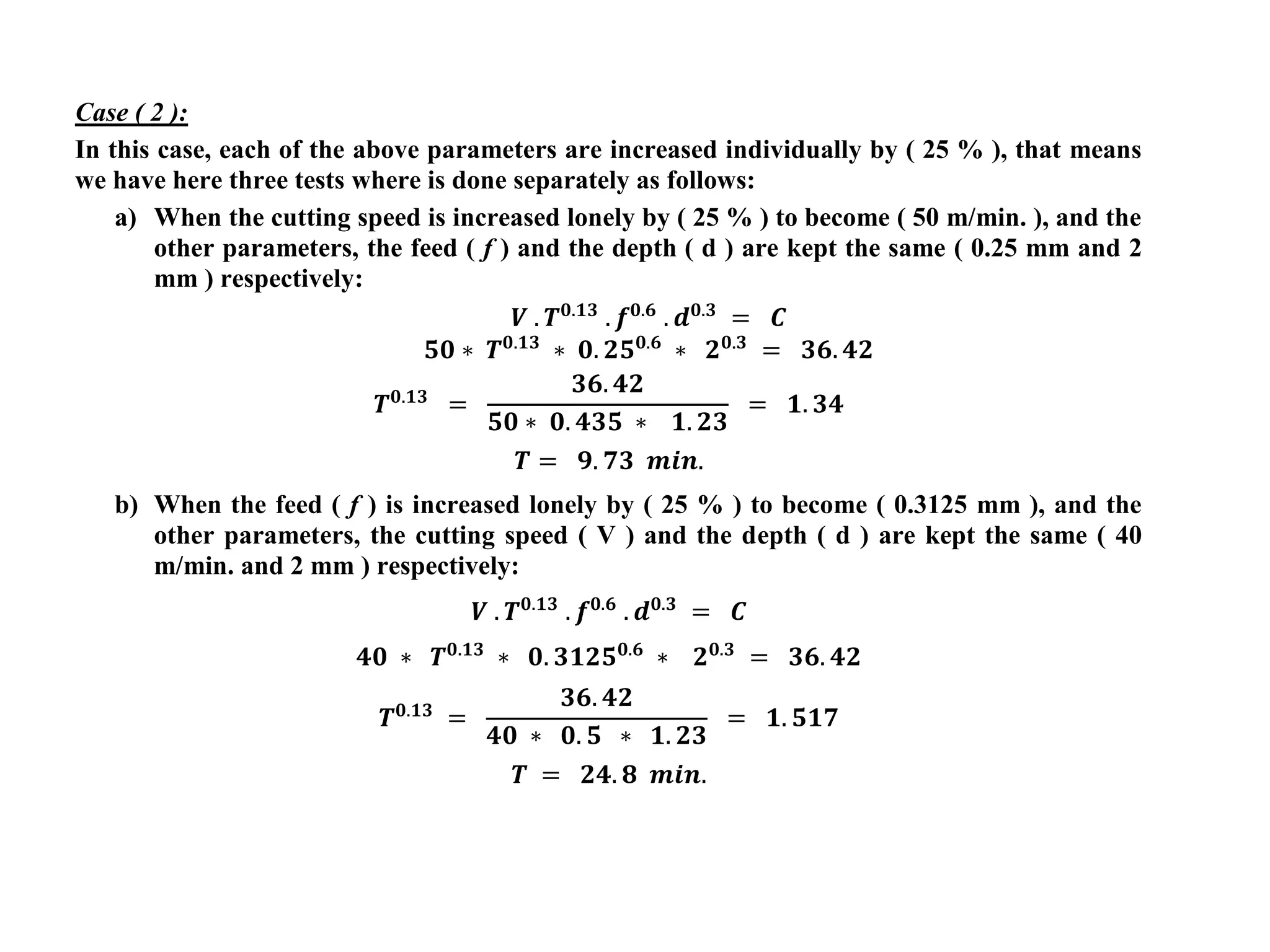The document discusses the generation of heat in metal cutting, with a significant portion dissipated by the chip, tool, and workpiece. It details the causes of tool wear and defines tool life, along with the Taylor tool life equation, which connects cutting speed and tool life. Additionally, it explains the role of cutting fluids in reducing heat and friction during machining, highlighting their importance in enhancing cutting performance and tool longevity.

![Cutting Temperature:
Almost all the work done in deformation the material to form the chip and move the chip and
the freshly cut work surface over the tool is converted into heat.
Figure (4) below shows the regions where the heat is primarily developed at the shear zone
(Q1), at the face tool [secondary zone (Q2)] and at tool workpiece interface (Q3).
Under normal conditions, the largest portion of
the work is done in forming the chip at the shear
plane (Q1), most the heat resulting from this
work remains in the chip is carried away by it,
while only a small percentage is conducted into
the workpiece.
(Q2) is the heat generated in the tool – chip
interface; it is due to friction between the chip
and the tool face.
(Q3) is the heat generated in tool – workpiece
interface, only a small percentage of the total
work done is converted into this heat.
Figure 4: Source of heat generation in
metal cutting.
That means:
Power = P = Fc . Vc = Q = Q1 + Q2,
where,Q_3 ≅ 0 which ignored since it is little](https://image.slidesharecdn.com/toollifecalcu-230106062229-d0fb5315/75/tool-life-calcu-pdf-2-2048.jpg)





![ Taylor Tool Life Equation:
It has been shown that the relationship between the tool live and the cutting speed can be
represented by the following equation [figure (7)]:
𝑽 . 𝑻𝒏
= 𝑪
Figure 7: Natural log–log plot of cutting speed versus
tool life.
𝑽 . 𝑻𝒏
= 𝑪
• T = tool life (min); and,
• ( n ) and ( C ) are parameters whose
values depend on feed, depth of cut,
work material, tooling (material in
particular), and the tool life criterion
used (flank wear value, such as 0.5
mm).
Where:
• Vc = cutting speed (m/min);
An expanded version of Taylor Equation can be formulated to include the effects of feed,
depth (width) of cut, and even work material hardness:
𝑽 . 𝑻𝒏
. 𝒇𝒎
. 𝒃𝒑
. 𝑯𝒒
= 𝑪
Where: f = feed, mm (in); b = depth (width) of cut, mm (in); H = hardness, expressed in an
appropriate hardness scale; [ m, p, and q ] are exponents whose values are experimentally
determined for the conditions of the operation; C = constant.
To reduce these problems and make the scope of the equation more manageable, some of the
terms are usually eliminated. For example, omitting depth and hardness reduces Equation to
the following:
𝑽 . 𝑻𝒏
. 𝒇𝒎
= 𝑪](https://image.slidesharecdn.com/toollifecalcu-230106062229-d0fb5315/75/tool-life-calcu-pdf-8-2048.jpg)


![Q1: Tool life tests on a lathe have resulted in the following data: (1) at a cutting speed of (
160 m/min ), the tool life was ( 5 min ); (2) at a cutting speed of ( 100 m/min ), the tool life was
( 41 min. ). Determine the parameters ( n and C ) in the Taylor tool life equation.
Solution:
Using the Taylor tool life equation:
𝑽 . 𝑻𝒏
= 𝑪
With the following data, [ V = 160 m/min. and T = 5 min.], we can obtain the following
equation:](https://image.slidesharecdn.com/toollifecalcu-230106062229-d0fb5315/75/tool-life-calcu-pdf-11-2048.jpg)


